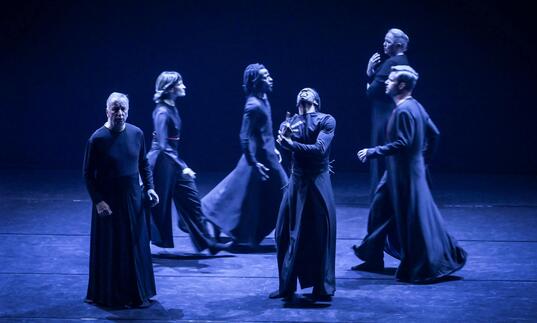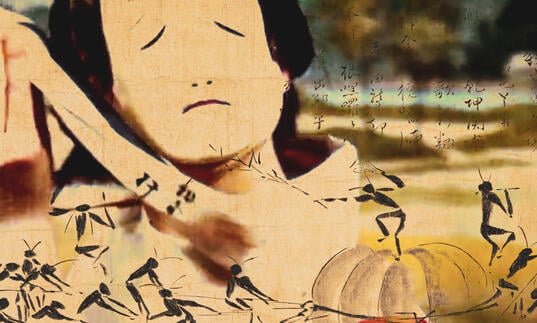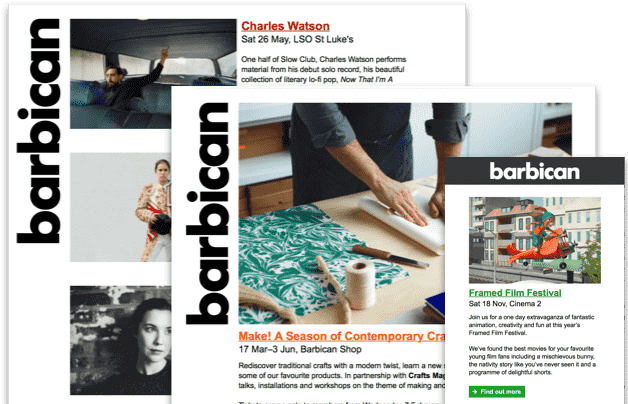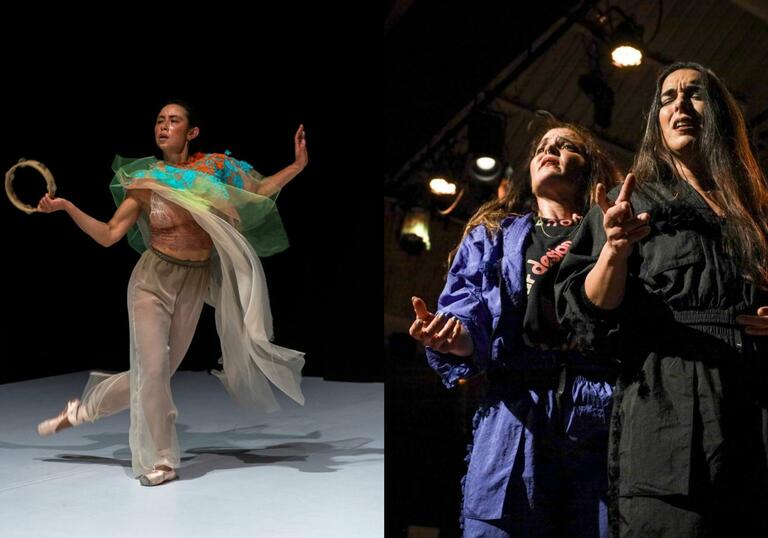
Change Tempo Creative team
SIREN DANCE
Concept, Choreographer and Performer Lilian Steiner
Composer Marco Cher-Gibard
Costume Designer Geoffrey Watson
Lighting Designer Giovanna Yate Gonzalez
Producer Freya Waterson
Technical Manager Froste Myrin
RANDOM TARANTO
Director, Creator and Performer María del Mar Suárez/La Chachi
Singer Lola Dolores
Composer, Sound Designer and Vocal Space María del Mar Suárez/La Chachi
Lighting Designer Azael Ferrer
Costumes / Scenography Designer María del Mar Suárez/La Chachi
Producer Inés Lambisto
Graphic Designer Carmen Moreno
Audiovisuals Designer Yolanda Montiel
Communication and Distribution Luisa Hedo
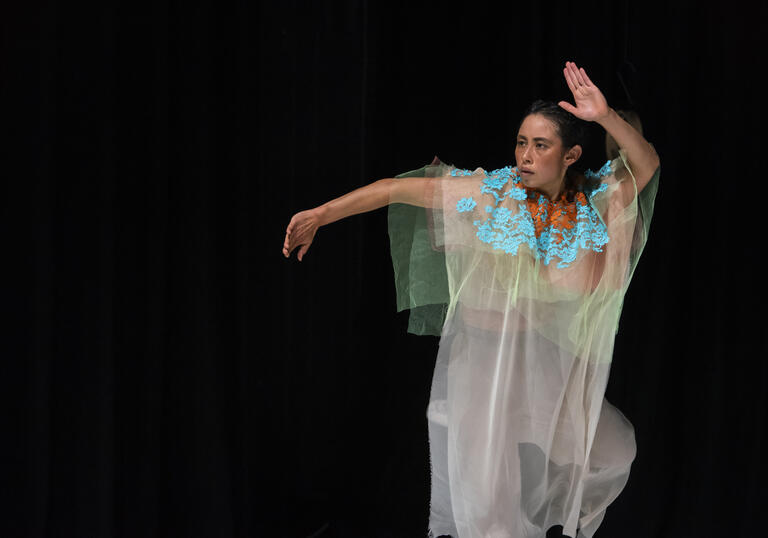
Event information
Running time: approximately 1 hour and 40 minutes, including a 20 minute interval.
Age guidance: 12+
Content warnings
Siren Dance includes a small amount of nudity and one loud scream (approximately 20 minutes into the show).
In Random Taranto, sunflower seeds are eaten on stage.
Presented by Dance Umbrella and Barbican
Supported by The City of London Corporation’s Inspiring London Through Culture Fund
Early research and premiere of Siren Dance was supported by Deltebre Dansa & B.Motion (Operaestate Veneto, Bassano del Grappa), Dancehouse Melbourne, Besen Foundation and Lucy Guerin Inc.
Fresh Perspectives
Interviews with Lilian Steiner and María del Mar Suárez/La Chachi ahead of their performances at the Barbican.
Lilian, has choreography always been built into your practice as a dancer?
LS: To me, working as a dancer has always been linked to choreographic practice – I’m always making decisions about how, what, where, when and for what purpose. Being a dancer is not just being a performer executing a work, it’s about consciously crafting the thing that I’m doing and working out how to share that.
I’ve been very lucky to work as a dancer for many other choreographers and in collaborations with visual- and sound-based artists, who have all asked me to be an active contributor to the creative process. I’m always bringing my own choreographic mind to these situations.
I started making my own work in 2012 and most of those works have been for ‘stages’ – for performance or theatrical contexts of various kinds. However, I’ve always been interested in the dynamic between dance and other forms (sound, visual and writing practices), and about how my experience of dance and being a dancer could translate into materialities beyond the body. In recent years, alongside live performance projects, my work has also manifested as sculptural objects, with the help of 3D motion capture, film projects and writing.
You describe your approach as having a focus on the intelligence of the body. What do you mean by that?
LS: I’ve been dancing since I was three, but the older I get, the more I value the many layers of attention one must have, the cognition and decision-making about every detail and all of them in simultaneous combination – how you can be busy with the positioning and tone in the eyes and the kind of tension and shaping of the face, while playing a certain relation to musicality in your own body, while waiting for a cue, while noticing sensations in your body, while noticing how the audience is looking at you, etc.
I think about ‘the body’ in its entirety – the physical, of course, but also the emotional, the cognitive, the social and the spiritual. Often the cognitive part can feel slower than other aspects of the body in reactiveness, and I’m interested in how embodiment as a whole is so complex and clever in its ability to take in its environment, process it and comment on it.
When you choreograph, are you mindful of how the production elements, the stage space and the different spaces that you visit on tour are going to affect the body's interaction with the choreography? How do you prepare for that?
LS: In my work as a choreographer, I see all aspects of the environment as choreographic choices. This includes the visual aesthetics but also the sound and lighting. It matters to me what environment the audience immediately lands in, and through the choreography of each piece, I make choices about how to invite the audience to traverse a particular landscape.
In different venues the same work can feel different, which I like. The audience also plays such a big part in the feeling of the environment, and with them, I will experience things differently on a Friday night to a Tuesday night, for example. The energy bubbles differently on different days and in different spaces. All of those things affect the body, whether the work is improvised or not. Navigating the differences is always part of the work.
This double bill is presenting work that challenges traditional forms of dance. Can you explain how this relates to your work?
LS: In making Siren Dance, I was particularly interested in a slipperiness of expectations. I did quite a lot of ballet and pointe work as a young person and I’ve always been drawn to the pointe shoe as an object. It really alludes to ethereality: it gives a quality of floating, ‘magically’ enabling a human to hover above the ground. It makes me feel superhuman. But I also see it as dagger-like – it pierces the ground in the way it makes contact, like a weapon. Also, it’s a very hard and tight shoe! It creates a unique type of pain for the person wearing it, which juxtaposes the light, airy quality it enables. These dichotomies of beauty and horror, or what is pleasant or severely unpleasant, lie in the same object. This is interesting to me and it felt right to utilise this elusive and deceptive power in Siren Dance.
In the first part of the work, I play with an expectation of classicism that gets subverted and turns into something a bit more aggressive or hostile, and then in the second part – without giving too much away – there’s a big turning point where this classical figure descends into a swampy underworld. The entirety of the body and its seductive language is transformed.
You created Siren Dance a few years ago. Has it evolved much since the original?
LS: The work in its full form premiered in March 2022, and since then I’ve had a few opportunities to perform it, always with big chunks of time between. Every time I come back to it there are new influences in my body from other people I have worked with or projects I’ve done which have laid the body up with new stuff. It’s both a blessing and a curse to figure out how to come back to this work: it really challenges me, which I’m happy about.
Could you describe the core theme of the piece?
LS: The work stemmed out of a personal life shift and an idea of seeing something, somebody or an opportunity as being shiny and wanting to move towards that thing. In Siren Dance, as in many circumstances in life, there’s a two-way seduction: this thing seduces us and we attempt to seduce it back to see our desire or curiosity fulfilled. In the Myth of the Sirens, the closer the ship gets to the song of the Sirens it becomes clear that the wondrous beauty is actually dragging them towards their doom, towards total disaster. The thing that was alluring can suddenly become a destructive force.
There's also that very human aspect of wanting to follow desire and the unknown but needing to be ready for it to disappoint, for reality not to be as you perceived it. So we never really land where we thought we would, and we have to keep dealing with what the moment presents. The extremely beautiful situational scenario and the really chaotic one sit together simultaneously. These moments are full of aliveness. One last comment, and perhaps most essentially, Siren Dance is about allowing ourselves to park our expectations and to find pleasure in surprise.
...
María, how did you discover this hybrid form of traditional Flamenco with contemporary dance and physical theatre?
María del Mar Suárez/La Chachi (MdMS): I have been a Flamenco dancer since I was four years old. I'm an actress and dancer, and graduated in both disciplines in my hometown of Malaga. I specialised in Flamenco with La Lupi, and trained in gestural theatre, new dramaturgy and contemporary dance. All of those different disciplines combine to form the world I now work in. Everything stems from my Flamenco roots, it is my way of expressing myself.
What is Taranto?
MdMS: Taranto is a formal study of a Flamenco style. It respects the structure and the internal dramaturgy of Flamenco, and it respects the codes of dialogue between the singer and the dance. But it transforms from seriousness to celebration and it collides with my artform, which is what we were talking about before. There are actions and departures from the traditional style that transform the vocal, the rustic and spatial.
The title of your piece is Random Taranto: how much improvisation or choreography is there in the piece? And can you describe the sound aspects of the piece?
MdMS: In terms of the vocal sound, we have adopted traditional lyrics. These are the lyrics that I dance on the tablao (the traditional wooden Flamenco platform) and are from Taranto and Tango – the piece ends with Tango, which Lola learned. The premise of Random Taranto is physical games into which I intervene with random actions. Everything that can be done with the body can be done with the voice. We use that theory in the game. The beginning and the end are improvised using material that is prepared – it is fixed material but it falls in different ways. Everything else is choreographed and set.
As performers you work closely together. Can you describe the process of creating this piece?
MdMS: I created the piece – the music, the structure, the sound – and Lola, as a Flamenco performer, interprets from that. Lola makes it possible for me to do all of this because she has versatility and plasticity, and picks up everything I throw at her. She takes it and she can make it happen. She isn’t just a singer.
When we perform this piece, Lola and I feel a shared vibration with the audience in which little by little they enter into the codes of the relationship between the two characters. The gradual transformation into the party feels very Flamenco but at the same time contemporary.
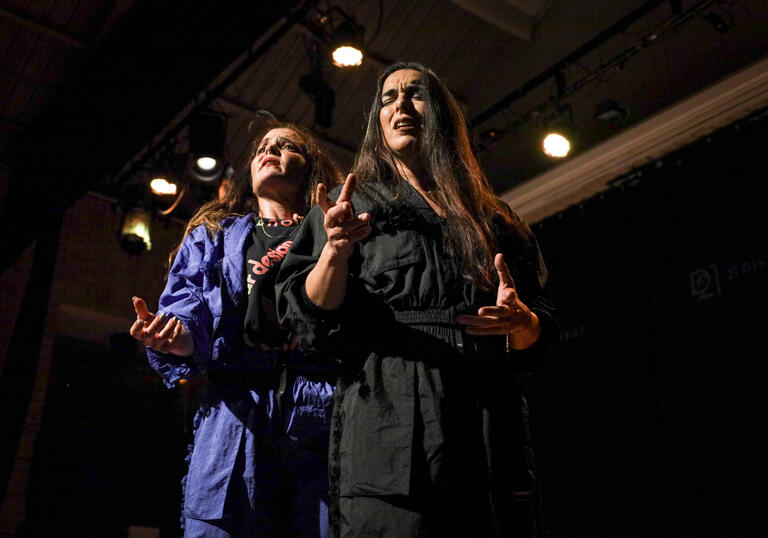
The Artists
Lilian Steiner
Lilian Steiner is an Australian choreographer, dancer and performer. Currently, she is based in Stockholm, Sweden, where she has been a dancer for Cullberg since August 2023.
Her practice champions the deep intelligence of the body and its unique ability to reveal and comment on the complexities of contemporary humanity. Her interests extend into visual arts and experimental sound practices where the body is the base for questioning and expression. Over the last decade, she has created numerous choreographic works that have been presented in Australia and Europe.
As a performer, Lilian Steiner works across independent and company environments within both dance and the visual arts. Since 2011, she has been a dancer with Lucy Guerin Inc across many projects and has also worked with Australian choreographers Phillip Adams’ BalletLab, Melanie Lane and Shelley Lasica, amongst many others. She has also collaborated with architect Matthew Bird, sound Artist Anna Homler and composer JLIN.
Lilian Steiner has won multiple awards in Australia for her work as a dancer, including three Green Room Awards (2023, 2018, 2017) and a Helpmann Award (2017) for best dancer. She also won a Green Room Award for concept and realisation for her work Noise Quartet Meditation (2015).
María del Mar Suárez/La Chachi
María del Mar Suárez, known as La Chachi, has earned her place in the tradition of breaking down and reassessing Flamenco, following the path of artists including El Niño de Elche, Israel Galván and Rocío Molina. An actress and dancer, she graduated in both disciplines in Málaga, her hometown. After specialising in flamenco with La Lupi, she trained in physical theatre, new dramaturgy and contemporary dance, before discovering her true passion: the union of all these disciplines. La Chachi has been twisting the traditional Flamenco language since 2008 to fit it to her unique style, where hybridisation is the norm. She made her first piece, La gramática de los mamíferos (The Grammar of Mammals) in 2017, receiving several nominations and awards. Her second work, La Espera, received support from Teatros del Canal (Madrid) and was programmed at the Teatro Central in Sevilla. Los inescalables Alpes, buscando a Currito (The Unclimbable Alps, Looking for Currito) was presented at Festival de Otoño of Madrid, and in 2022 received the Godot Dance Award. In January 2025, she presented her most recent work, Lâs Alegrías, in Centro Conde Duque, Madrid.
Lola Delores
Born in 1983 in Puente Genil, Córdoba, Lola Dolores has lived in Málaga since 1988. Her family instilled in her a deep passion for Flamenco, leading her to sing and develop a profound respect for the art form from an early age. She is also self-taught in various musical styles, including soul, pop, R&B, and rock. With a diverse and extensive career as a backing vocalist for pop, Flamenco and urban artists, she worked with La Mala Rodríguez, among others, touring both nationally and internationally between 2007 and 2010. Later, she pursued acting studies at the Málaga School of Dramatic Art (ESAD) and has since performed in a variety of theatre productions spanning different genres and collaborations. Currently, she is exploring new musical projects and actively collaborates with María del Mar Suárez’s company, La Chachi, as well as Luz Arcas’ La Phàrmaco. As part of María del Mar Suárez’s company, she has contributed to productions such as La Gramática de los Mamíferos, La Espera, Los Inescalables Alpes, buscando a Currito, Taranto Aleatorio and Lâs Alegrías, the last three of which are currently on tour.
Les Arts Florissants & Amala Dianor Company: Gesualdo Passione presented with Dance Umbrella
Classical, modern and hip hop styles combine in this unique stage creation that blends a capella singing with expressive movement.
About Dance Umbrella
Dance Umbrella is a London festival 47 years in the making and moving with the times.
Every year our festival ignites London and online with the next generation of trailblazing artists. Since 1978, we have been an international home for dance across a global city, presenting more than 1,000 artists from 45 countries to over one million people. We have brought outstanding dance to more than 145 venues throughout London; from the high-profile stages of Sadler’s Wells, Southbank Centre and Barbican to local arts centres – and taking in the more unexpected locations of canal boats, ice rinks and car park rooftops in between.
Since 2020, we have also given online audiences the chance to experience the festival through a curated programme including dance films and artist encounters. Dance Umbrella is a commissioner of new work, co-producing with partners based in the UK and abroad, to invest in the next wave of international choreographic talent.
Appointed in 2021, Dance Umbrella’s Artistic Director/CEO Freddie Opoku-Addaie‘s vision for the festival builds on its 46-year track record of commissioning and producing excellent work. This new chapter introduces a programme that puts emerging and diverse talent at its heart, reflecting the global identity of our London home.
Dance Umbrella Festival 2025
danceumbrella.co.uk/festival
Andrea Peña & Artists – BOGOTÁ
2 and 3 Oct, Sadler’s Wells East
https://danceumbrella.co.uk/event/andrea-pena-bogota/
Sites of Meaning: Culture & The Global City
3 Oct, Studio Wayne McGregor
https://danceumbrella.co.uk/event/sites-of-meaning-culture-and-the-global-city/
Brixton House Takeover with CASA Festival
4 Oct, Brixton House
https://danceumbrella.co.uk/event/brixton-house-takeover/
Lilian Steiner and; María del Mar Suárez/La Chachi – Change Tempo
8 and; 9 Oct, The Pit Barbican
https://danceumbrella.co.uk/event/lilian-steiner-la-chachi-change-tempo/
Arts & Class panel discussion
10 Oct, Battersea Arts Centre
https://danceumbrella.co.uk/event/arts-class/
Ben Duke – Artist Encounters
11 Oct, Shakespeare’s Globe
https://danceumbrella.co.uk/event/artist-encounters-making-text-move/
Dance Umbrella Film Series – Sunday Shorts
12 Oct, Barbican Cinema 3
https://danceumbrella.co.uk/event/dance-umbrella-film-series-sunday-shorts/
Les Florissants & Amala Dianor Company – Gesualdo Passione
16 Oct, Barbican Hall
https://danceumbrella.co.uk/event/amala-dianor-gesualdo-passione/
Davi Pontes & Wallace Ferreira – Repertório N.1
18 and 19 Oct, Porchester Hall
https://danceumbrella.co.uk/event/davi-pontes-wallace-ferreira-repertorio-n-1/
Tjimur Dance Theatre – bulabulay mun? / how are you?
21 and 22 Oct, The Place
https://danceumbrella.co.uk/event/tjimur-dance-theatre-bulabulay-mun-how-are-you/
Elena Antoniou – LANDSCAPE
24 and 25 Oct, Shoreditch Town Hall
https://danceumbrella.co.uk/event/elena-antoniou-landscape/
Dance Umbrella Digital Pass 2025
Dance Umbrella has curated a fresh line-up of innovative dance films and audio conversations, as well as recorded panel discussions from this year’s festival. This digital offering is the perfect way to experience London’s international dance festival from wherever you are.
The Digital Pass is Pay What You Can and gives you access to the entire 2025 digital programme from 2 October – 30 November.
Find out more: https://danceumbrella.co.uk/digital-pass/
Dance Umbrella: Sunday Shorts
Join us for a screening of short films that draw on global perspectives and have movement at their heart.
For Dance Umbrella
Artistic Director & Co-Chief Executive Freddie Opoku-Addaie
Executive Director & Co-Chief Executive Tania Wilmer
Festival Producer Jessica Greer
Technical Director Andy Downie
Head of Marketing Lucy White
Digital Content Manager Isabella Hubbard
Head of Development Dawn Prentice
Festival & Development Administrator Katie Tucker
Dance Umbrella Festival Team
Assistant Producer Jasmine Andrews
Festival Assistant Isabella Gaynor
Front of House & Volunteer Manager Amy Johnson
DU Technical Team Jon Beattie, Carly Hook
Production Transport Edwin Shirley Limited
BSL Interpreters Vinessa Brant, Yasmin Jacobsen, Anna Kitson, Samuel Rojas, Rebekah Spencer
Press & PR Bread and Butter PR
Website & Digital Advertising HdK Associates
Film & Photography Rocio Chacon, Roswitha Chesher, Foteini Christofilopoulou, Henry Curtis, Monika Davies, Alice Underwood
Graphic Design Cat Lips Creative
Dance Umbrella Founder Val Bourne CBE
Dance Umbrella Patrons Jonzi D, Liz Lerman, Dame Arlene Phillips
Dance Umbrella Trustees Jake Ulrich (Chair), Peter Barker (Treasurer), Nikhil Bolton-Patel, Eva de Blocq van Kuffeler, Simelia Hodge-Dallaway, Alex Mecklenburg, Jacqueline Rose, Manohari Saravanamuttu, Naomi Simpson
Dance Umbrella charity registration number 277221
With thanks from Dance Umbrella
To our venue partners for your collaboration and for welcoming artists into warm venues. A huge thank you to the artists and the wider creative teams, for holding space for work that both challenges and brings wondrous joy to this global city and beyond.
Special thanks to Delia Barker, Eduardo Bonito, Jocelyn Burnham, Janine Fletcher, Dawn Langley, Wayne McGregor, Diego Nuñez Martins, Bethan Peters, Susan Royce, Ashleigh Ruxton, Amy Shepherd.
Julius Eastman: A Power Greater Than
Grammy nominated Davóne Tines celebrates Julius Eastman's work in this visceral and theatrical staging featuring choreography by Kyle Marshall.
For the Barbican
Barbican Centre Board
Chair
Sir William Russell
Deputy Chair
Tijs Broeke
Deputy Chair
Tobi Ruth Adebekun
Board Members
Munsur Ali, Michael Asante MBE, Stephen Bediako OBE, Aaron D’Souza, Zulum Elumogo, Robert Glick OBE, Jaspreet Hodgson, Sir Nicholas Lyons, Mark Page, Anett Rideg, Dr Jens Riegelsberger, Jane Roscoe, Irem Yerdelen
Barbican Centre Trust Chair
Robert Glick OBE
Trustees
Stephanie Camu, Cas Donald, David Farnsworth, Ann Kenrick, Sir William Russell, Sian Westerman OBE
Directors
Chief Executive Officer
David Farnsworth (Interim, until Dec 2025)
Abigail Pogson (from Jan 2026)
Deputy CEO (Interim) & Director for of People, Culture & Inclusion
Ali Mirza
Director of Development
Natasha Harris
Head of Finance & Business Administration
Sarah Wall
Director for Buildings & Renewal
Dr Philippa Simpson
Director of Commercial
Jackie Boughton
Director for Audiences
Beau Vigushin
Director for Arts and Participation
Devyani Saltzman
Executive Assistant to CEO
Hannah Hoban
Executive Business Manager to the CEO
Abigail Carlin
Theatre Department
Head of Theatre and Dance
Toni Racklin
Senior Production Manager
Simon Bourne
Producers
Liz Eddy, Jill Shelley, Fiona Stewart
Assistant Producers
Mrinmoyee Roy, Mali Siloko, Tom Titherington
Production Managers
Jamie Maisey, Lee Tasker
Technical Managers
Steve Daly, Jane Dickerson, Nik Kennedy, Martin Morgan, Stevie Porter
Stage Managers
Lucinda Hamlin, Charlotte Oliver
Technical Supervisors
Malhar Kawre, Charlie Mann, Josh Massey, Matt Nelson, Adam Parrott, Lawrence Sills, Chris Wilby
Technicians
Martin Black, Kendell Foster, David Kennard, Burcham Johnson, Bart Kuta, Christian Lyons, Blaine Mitchell, Fred Riding, Fede Spada, Matt Turnbull
PA to Head of Theatre
David Green
Production Administrator
Caroline Hall
Production Assistant
Ashley Panton
Stage Door
Julian Fox, aLbi Gravener
Marketing Department
Head of Marketing
Jackie Ellis
Deputy Head of Marketing
Ben Jefferies
Senior Marketing Manager
Kyle Bradshaw
Marketing Manager
Rebecca Moore
Marketing Assistants
Maria Andaya, Ossama Nizami
Communications Department
Senior Programming Communications Manager
Hannah Carr
Press Consultant
HBL
Communications Officer
Sumayyah Sheikh
Communications Assistant
Andrea Laing
Heads of Department
Head of Cinema
Rebecca Fons
Head of Visual Arts
Shanay Jhaveri
Head of Creative Collaboration
Karena Johnson
Head of Creative Programming, Immersive
Luke Kemp
Head of Commercial Partnerships and Strategy, Immersive
Patrick Moran
Head of Cross Arts Planning and Strategic Operations
Fiona Pride
Head of Music
Helen Wallace
Audience Experience
Senior Audience Experience Managers
Oliver Robinson, Liz Davies-Sadd
Ticket Sales Managers
Lucy Allen, Jane Thomas, Bradley Thompson, Alex Steggles
Ticket Sales Team Leaders
Molly Barber, Máire Vallely, Nicola Watkinson, Charlotte Day
Operations Managers
Tabitha Fourie, Aksel Nichols, Ben Raynor, Mo Reideman, Samantha Teatheredge, Hayley Zwolinska
Audience Event & Planning Manager
Freda Pouflis
Venue Managers
Catherine Campion, Scott Davies, Maria Pateli, Lotty Reeve, Shabana Zaman
Assistant Venue Managers
Sam Hind, Bronagh Leneghan, Melissa Olcese, Daniel Young
Crew Management
Dave Magwood, Rob Magwood
Access and Licensing Manager
Rebecca Oliver
Security Operations Manager
Naqash Sheikh
Audience Experience Coordinator
Ayelen Fananas
With thanks
The Barbican sparks creative possibilities and transformation for artists, audiences and communities – to inspire, connect, and provoke debate.
As a not-for-profit, we need to raise 60% of our income through fundraising, ticket sales, and commercial activities. With the help of our generous supporters, we are able to share the work of some of the most inspiring and visionary artists and creatives, enabling the widest possible audience to experience the joy of the arts.
We’re passionate about expanding access to ensure anyone can participate in art and creativity in London and beyond. From our work with local schools to provide unforgettable learning experiences, to development opportunities for emerging creatives, to discounted tickets to our events, your support helps us make a real difference every day.
There are many ways you can support the Barbican, including by making a donation, joining our programme as a sponsor, or becoming a Member. To find out more and join our community, please visit www.barbican.org.uk/join-support/support-us or contact [email protected]
Founder and Principal Funder
The City of London Corporation
Major Supporters
Bagri Foundation
Bukhman Foundation
In Memory of John Murray
Kiran Nadar Museum of Art
SHM Foundation
Tia Collection
Leading Supporters
Trevor Fenwick and Jane Hindley
Marcus Margulies
Programme Supporters
Blanca and Sunil Hirani
Clore Wyndham
Erica Roberts
Estrellita and Daniel Brodsky
Harry G. David
Goodman Gallery
Lonti Ebers
MENAEA Collection, Kuala Lumpur
Mandy Cawthorn Argenio
Natasha Sidharta
Romilly Walton Masters Award
The Rudge Shipley Charitable Trust
Barbican Patrons
Director’s Circle
James and Louise Arnell
Farmida Bi CBE
Philippe and Stephanie Camu
Cas Donald
Alex and Elena Gerko
Trevor Fenwick and Jane Hindley
Professor Dame Henrietta L. Moore
Daniel Siddall
Sir Howard Panter and Dame Rosemary Squire
Sir William and Lady Hilary Russell
Ben Warner
Sian and Matthew Westerman
Principal Patrons
Natrium Capital Limited
S.Ghanbari
Ruth and Stuart Lipton
James Penney
James Drummond
Premier Patrons
Abdullah B.S. Al-Saud
Sam and Rosie Berwick
Lynn Biggs
Dame Elizabeth and Mr Michael Corley
Dicle Guntas
Julian Hale and Helen Likierman
Sir Nicholas and Lady Felicity Lyons
Soo Hitchin
Isabelle Pasa
Jens Riegelsberger
Philip Romanos
Sir Paul and Lady Jill Ruddock
Richard Russell
Romilly Walton Masters Award
Rebel Wilson
T. Volkheimer and J. Hollister
Patrons
Matt Astill
Zumrut Arol
Dr Denise Bennett
Nicholas Berwin
Jo and Tom Bloxham MBE
Professor Geraldine Brodie
Adam Chamberlain
Tony Chambers CBE
F. Charlwood
Tim and Caroline Clark Dr Gianetta Corley
Erica and Neil Cosburn
Matthew Courey
Tim and Catherine Cox
Fernanda Diamant
Davide Giordano
Robert Glick OBE
Felicity Guinness
Richard Hardie
Malcolm Herring
Charles Hoare Nairne
Sajid Hussein
David Kapur
Ann Kenrick
Phillip Keir
Colin Kirkpatrick
Neil and Tracy Lawson-May
Peter Lim
Susan Lim
Mrs Flora Lyon
Jack Mactaggart
Camilla Mash
Frederic Marguerre
Mayerson Family
Robert McHenry and Sally Lloyd-Bostock
Andrew McIver
Sir Paul Morgan and Sheila Harvey
Siobhan and Simon Morgan
Sharon Newton
Professor Dame Linda Partridge and Mr Michael Morgan Mark Page
Oliver Pauley
Ben and Christina Perry
Keith Salway
Nicola Sawford and Michael Hadi
Carlos and Devy Schonfeld
Richard and Elizabeth Setchim
Stephan Solomonidis
Mary Tapissier and family
Philip and Irene Toll Gage Foundation
Steven Tredget
Richard Williams
Robert Willicombe
Sarah Wood Irem Yerdelen
Sonya Zuckermanand to all those who wish to remain anonymous
Corporate Partners
Apple Original Films
Audible
Bloomberg Philanthropies
Culture Mile BID
Google Arts & Culture
Mastercard
Sotheby’s
Taittinger
TOAST
Corporate Members
American International Group, Inc.
Bank of America
Bloomberg
BMO
Bolt Burdon Kemp
Deutsche Bank
DLA Piper UK LLP
Linklaters LLP
Macfarlanes LLP
Norton Rose Fulbright
Osborne Clarke
Pinsent Masons
Slaughter and May
Standard Chartered
UBS
Trusts & Grantmakers
Adam Mickiewicz Institute
The Ampersand Foundation
Art Fund
Aspect Charitable Trust
CHK Foundation
Cockayne – Grants for the Arts
John S Cohen Foundation
The Daiwa Anglo-Japanese Foundation
Embassy of Ireland
Embassy of the Kingdom of the Netherlands
The Garrick Charitable Trust
Goethe-Institut London
The Great Britain Sasakawa Foundation
Henry Moore Foundation
Institut français du Royaume-Uni
Korean Cultural Centre UK
Lucille Graham Trust
Mactaggart Third Fund
Performing Arts Fund NL
Polish Cultural Institute London
Royal Norwegian Embassy in London
Stanley Thomas Johnson Foundation
We also want to thank Barbican Members and the many thousands who made
a donation when purchasing tickets.
The Barbican Centre Trust Ltd, registered charity no. 294282
